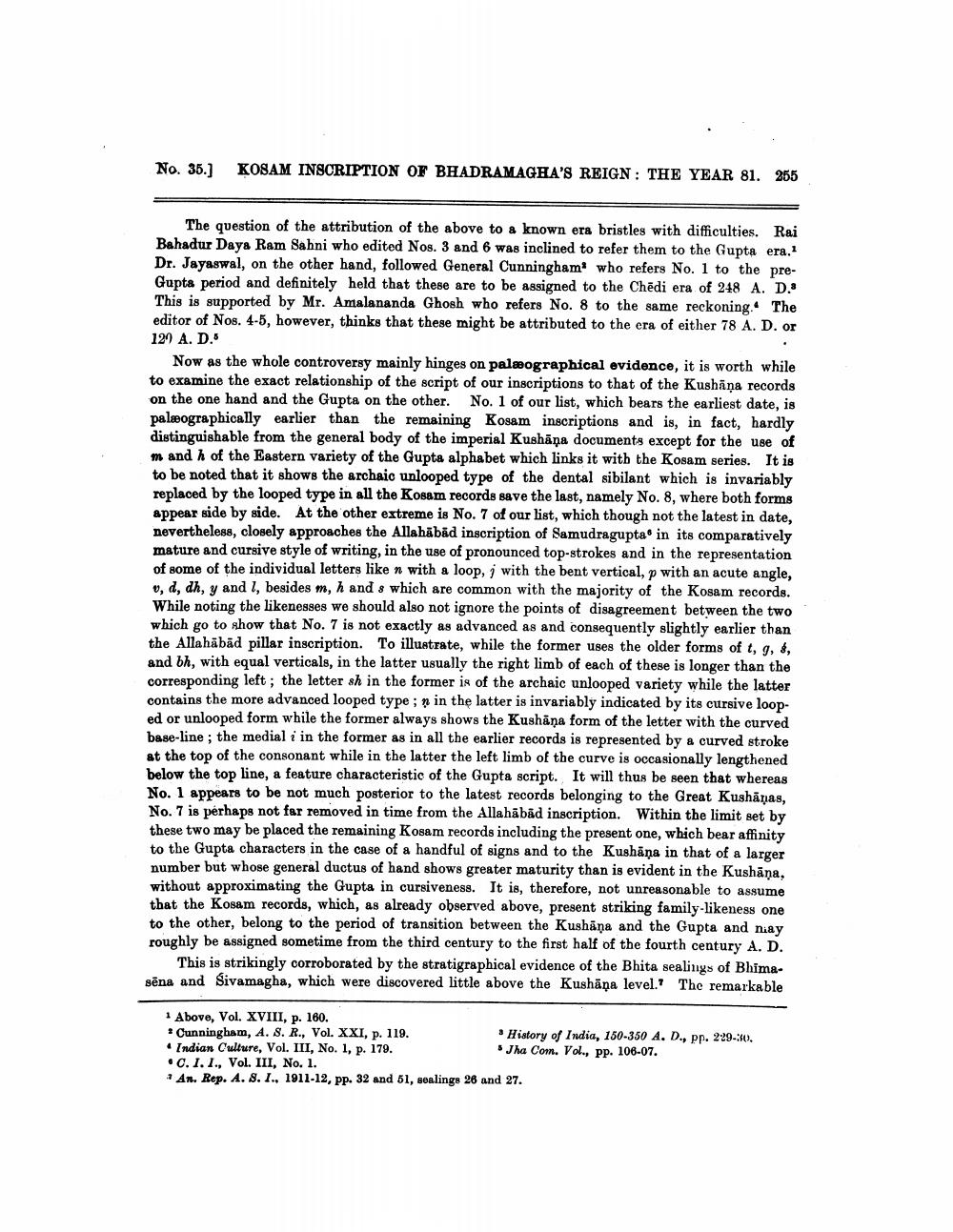________________
No. 35.)
KOSAM INSCRIPTION OF BHADRAMAGHA'S REIGN: THE YEAR 81. 255
The question of the attribution of the above to a known era bristles with difficulties. Rai Bahadur Daya Ram Sahni who edited Nos. 3 and 6 was inclined to refer them to the Gupta era.? Dr. Jayaswal, on the other hand, followed General Cunningham who refers No. 1 to the preGupta period and definitely held that these are to be assigned to the Chēdi era of 248 A. D: This is supported by Mr. Amalananda Ghosh who refers No. 8 to the same reckoning. The editor of Nos. 4-5, however, thinks that these might be attributed to the era of either 78 A. D. or 120 A. D."
Now as the whole controversy mainly hinges on palæographical evidence, it is worth while to examine the exact relationship of the script of our inscriptions to that of the Kushāņa records on the one hand and the Gupta on the other. No. 1 of our list, which bears the earliest date, is palæographically earlier than the remaining Kosam inscriptions and is, in fact, hardly distinguishable from the general body of the imperial Kushāņa documents except for the use of m and h of the Eastern variety of the Gupta alphabet which links it with the Kosam series. It is to be noted that it shows the archaic unlooped type of the dental sibilant which is invariably replaced by the looped type in all the Kosam records save the last, namely No. 8, where both forms appear side by side. At the other extreme is No. 7 of our list, which though not the latest in date, nevertheless, closely approaches the Allahābād inscription of Samudragupta in its comparatively mature and cursive style of writing, in the use of pronounced top-strokes and in the representation of some of the individual letters like n with a loop, with the bent vertical, p with an acute angle, o, d, dh, y and I, besides m, h and 8 which are common with the majority of the Kosam records. While noting the likenesses we should also not ignore the points of disagreement between the two which go to show that No. 7 is not exactly as advanced as and consequently slightly earlier than the Allahābād pillar inscription. To illustrate, while the former uses the older forms of t, g, $, and bh, with equal verticals, in the latter usually the right limb of each of these is longer than the corresponding left; the letter sh in the former is of the archaic unlooped variety while the latter contains the more advanced looped type; n in the latter is invariably indicated by its cursive looped or unlooped form while the former always shows the Kushāna form of the letter with the curved base-line; the medial i in the former as in all the earlier records is represented by a curved stroke at the top of the consonant while in the latter the left limb of the curve is occasionally lengthened below the top line, a feature characteristic of the Gupta script. It will thus be seen that whereas No. 1 appears to be not much posterior to the latest records belonging to the Great Kushānas, No. 7 is perhaps not far removed in time from the Allahābād inscription. Within the limit set by these two may be placed the remaining Kosam records including the present one, which bear affinity to the Gupta characters in the case of a handful of signs and to the Kushāņa in that of a larger number but whose general ductus of hand shows greater maturity than is evident in the Kushāna, without approximating the Gupta in cursiveness. It is, therefore, not unreasonable to assume that the Kosam records, which, as already observed above, present striking family-likeness one to the other, belong to the period of transition between the Kushāna and the Gupta and niay roughly be assigned sometime from the third century to the first half of the fourth century A. D.
This is strikingly corroborated by the stratigraphical evidence of the Bhita sealings of Bhimasēna and Sivamagha, which were discovered little above the Kushāņa level. The remarkable
1 Above, Vol. XVIII, p. 160. • Cunningham, A. S. R., Vol. XXI, p. 119.
• History of India, 150-350 A. D., pp. 229-30. • Indian Culture, Vol. III, No. 1, p. 179.
* Jha Com. Vol., pp. 106-07. .C.1.., Vol. III, No. 1. - An. Rep. A. 8. I.. 1911-12, pp. 32 and 51, sealings 26 and 27.




